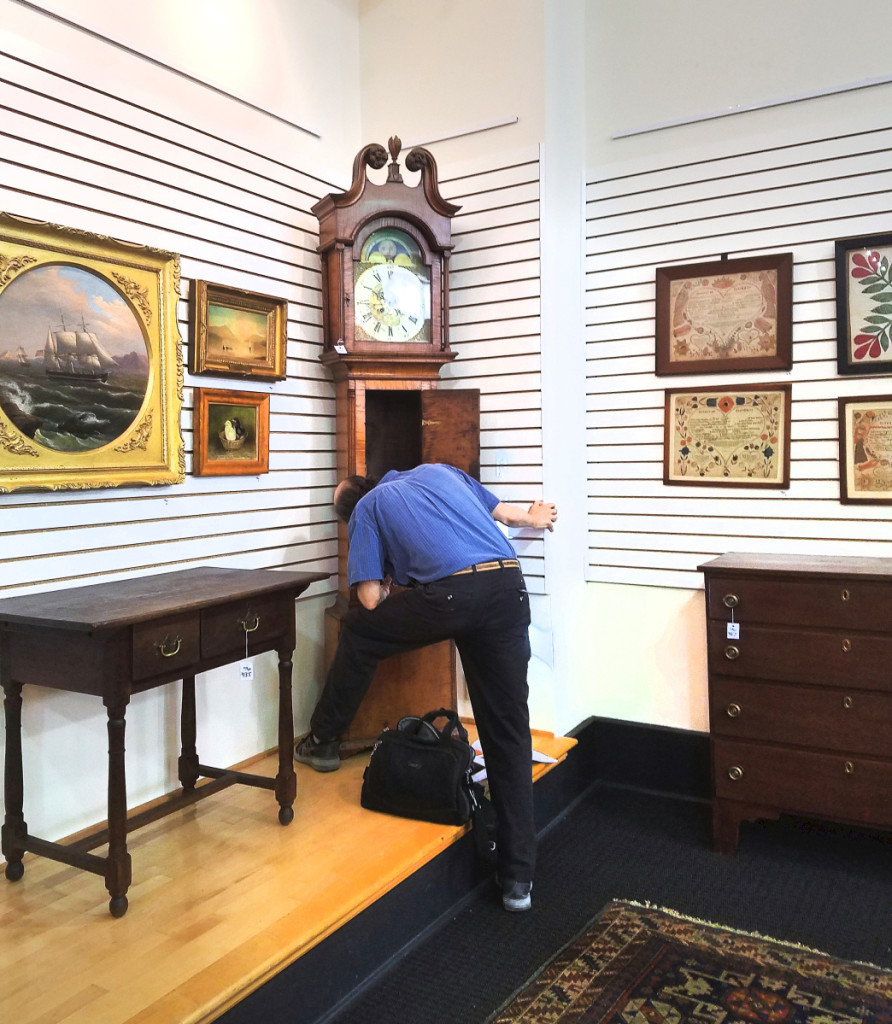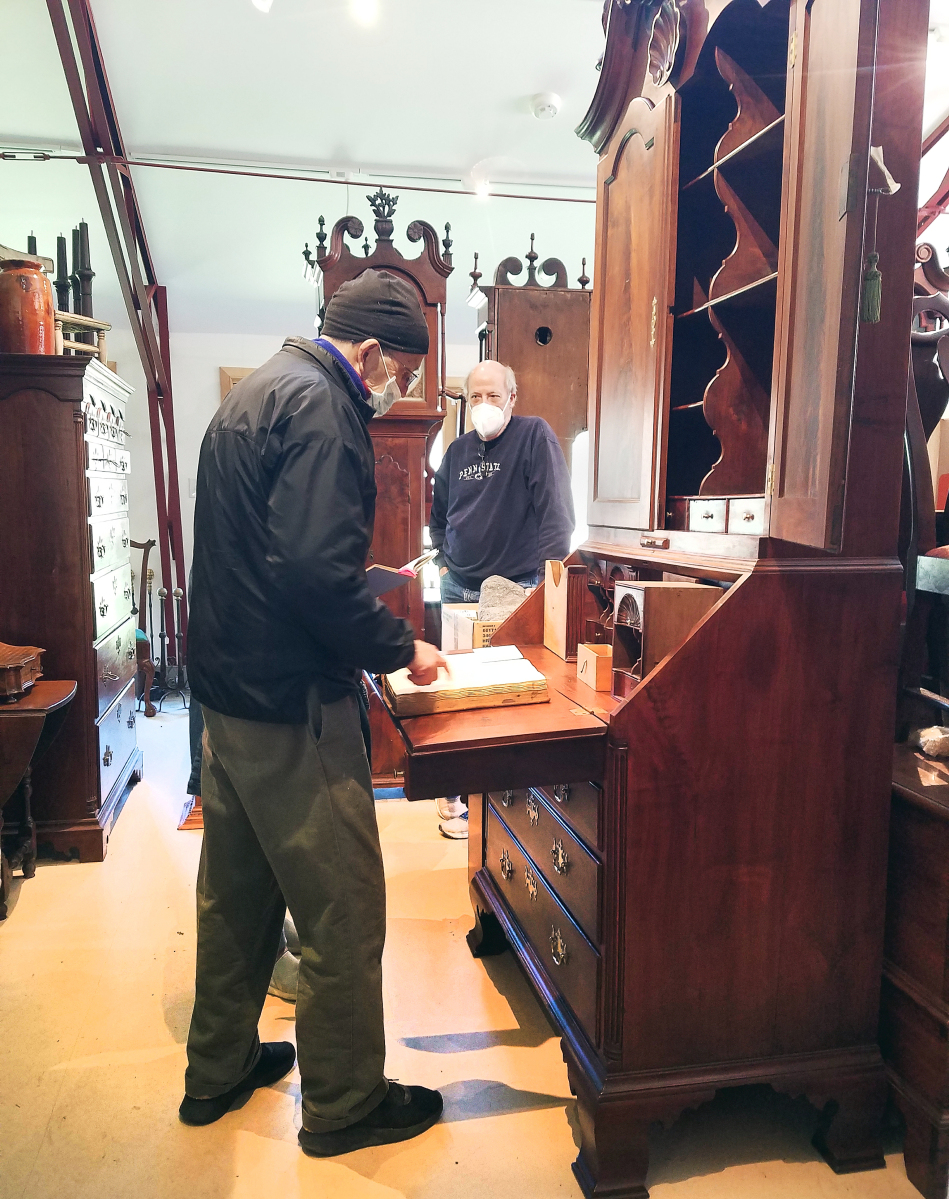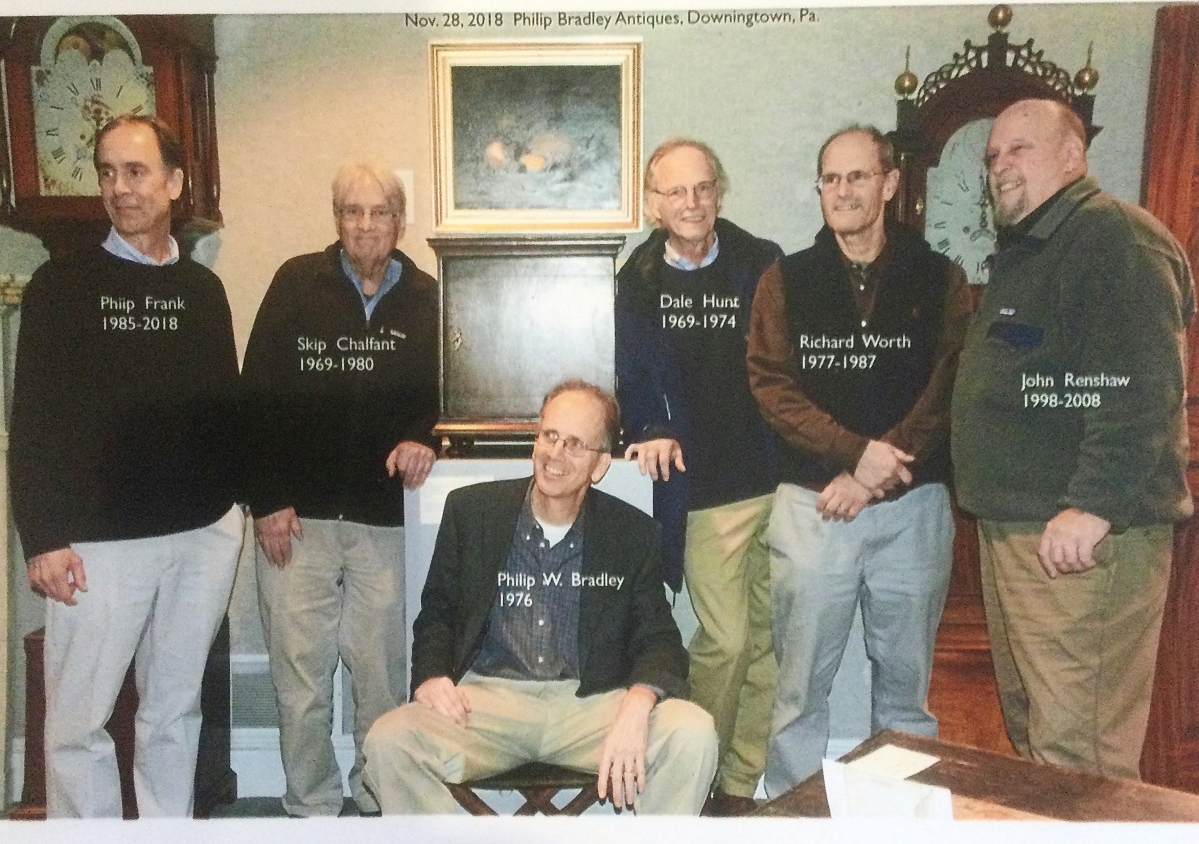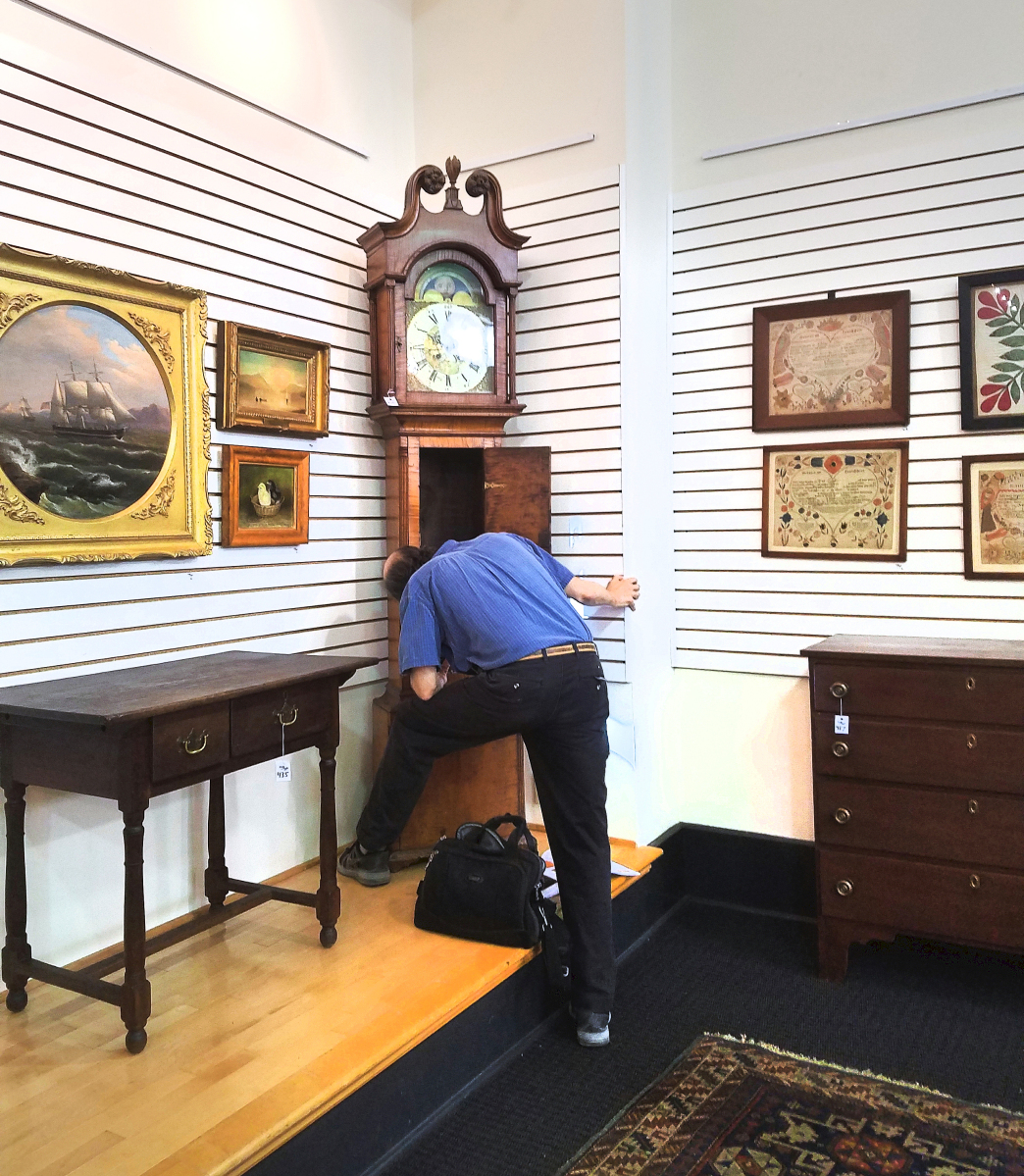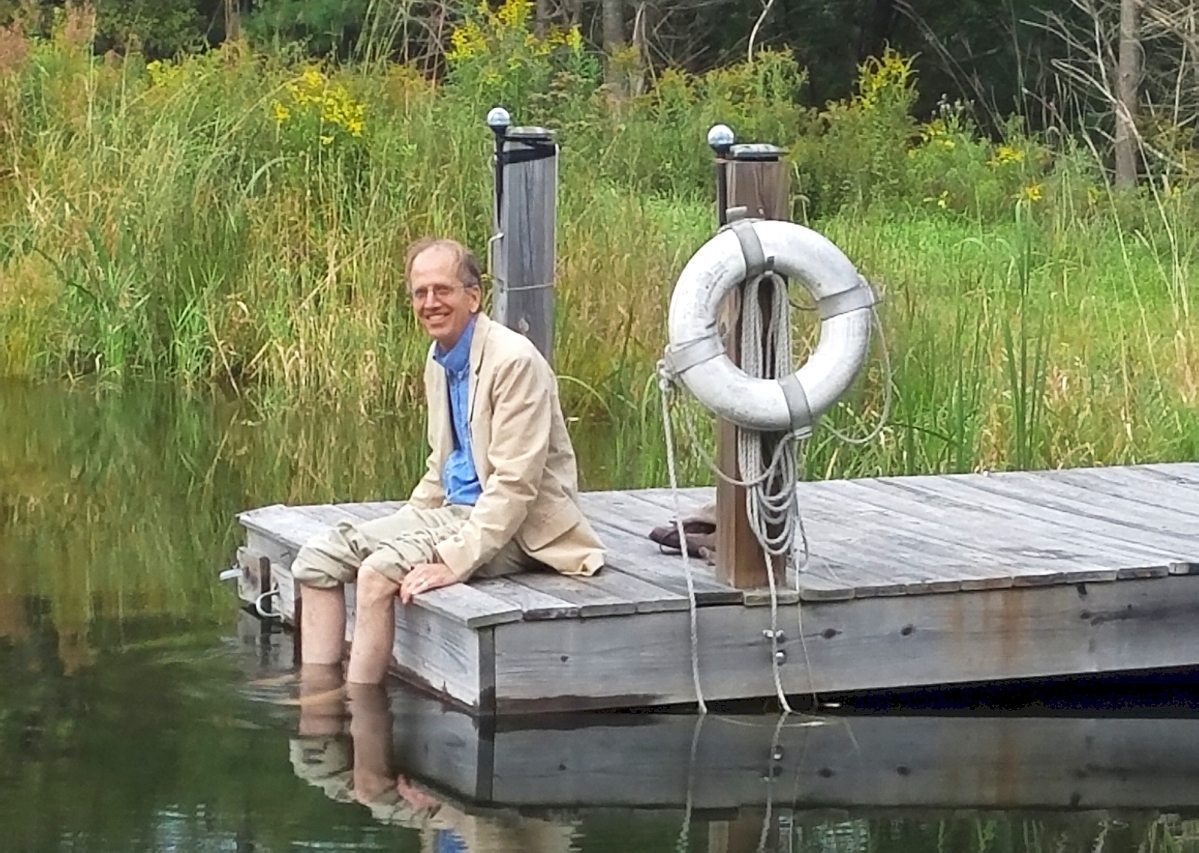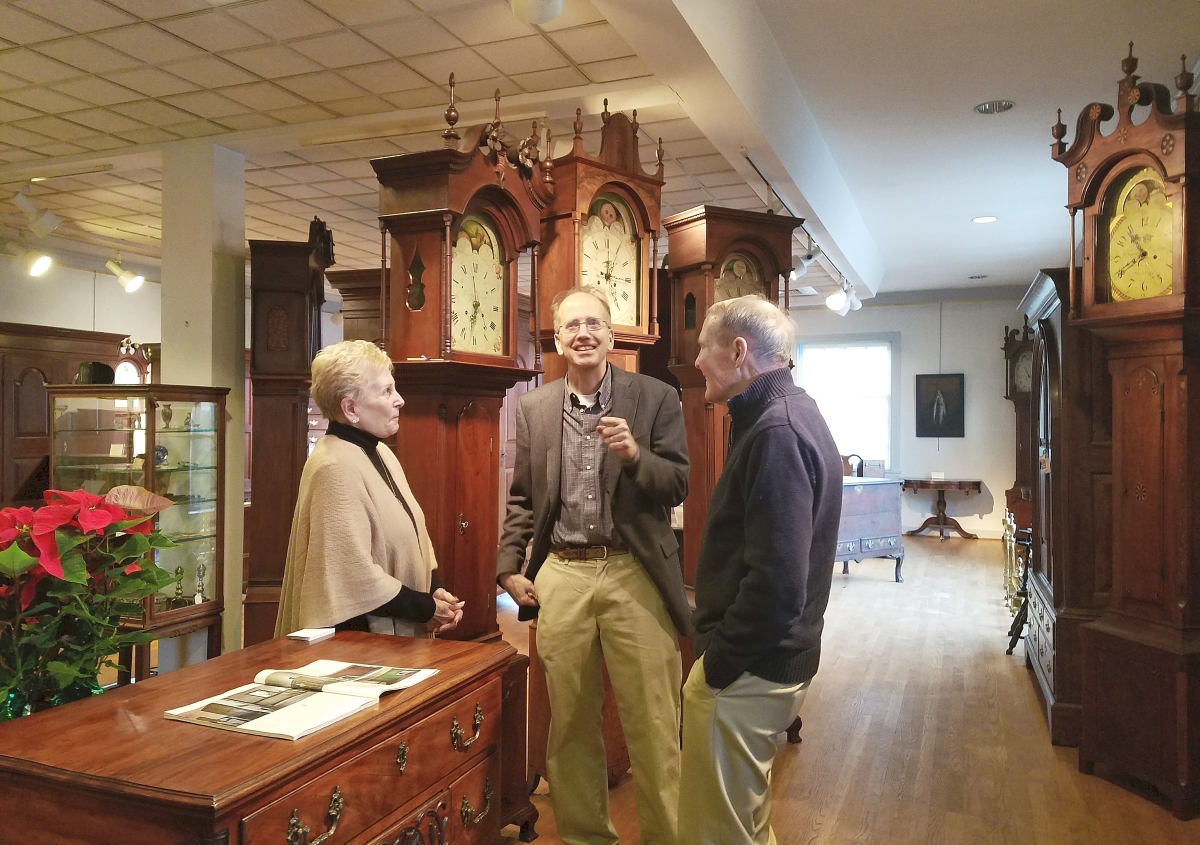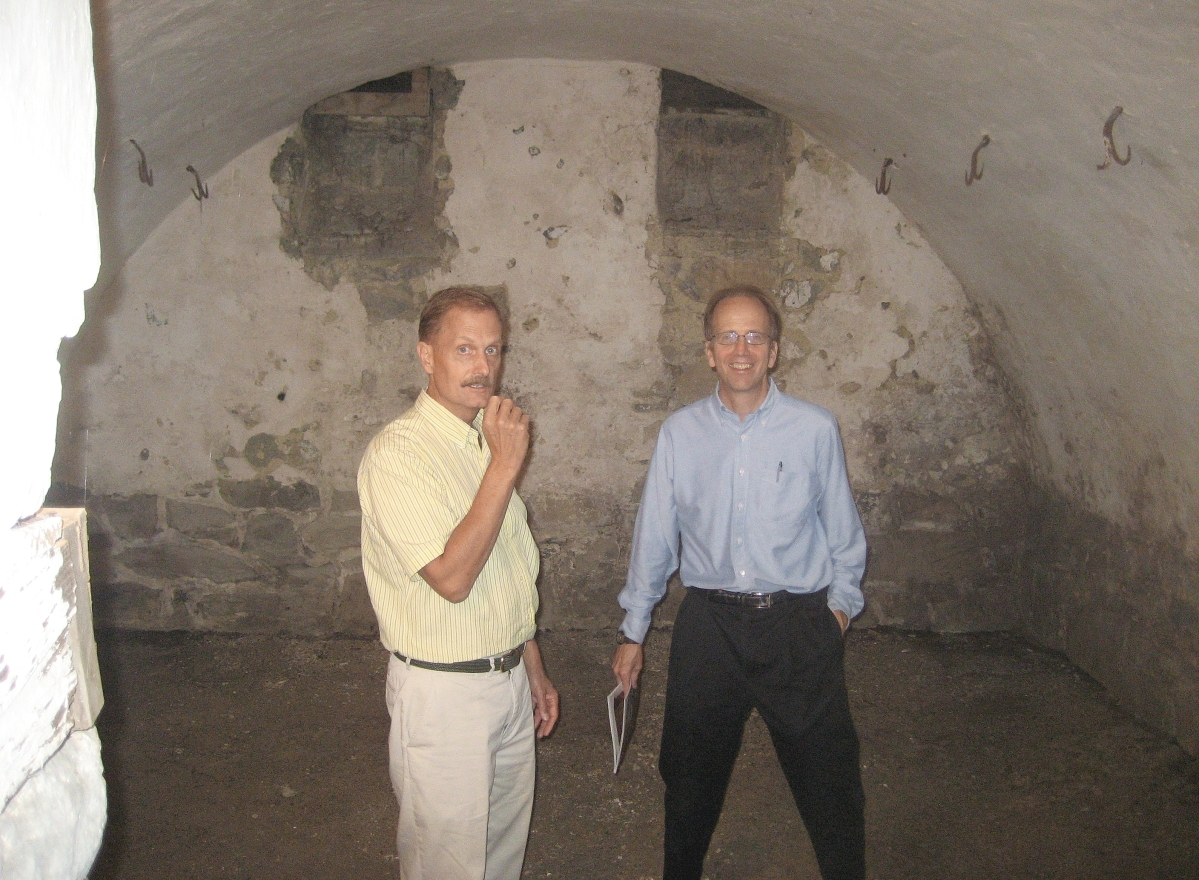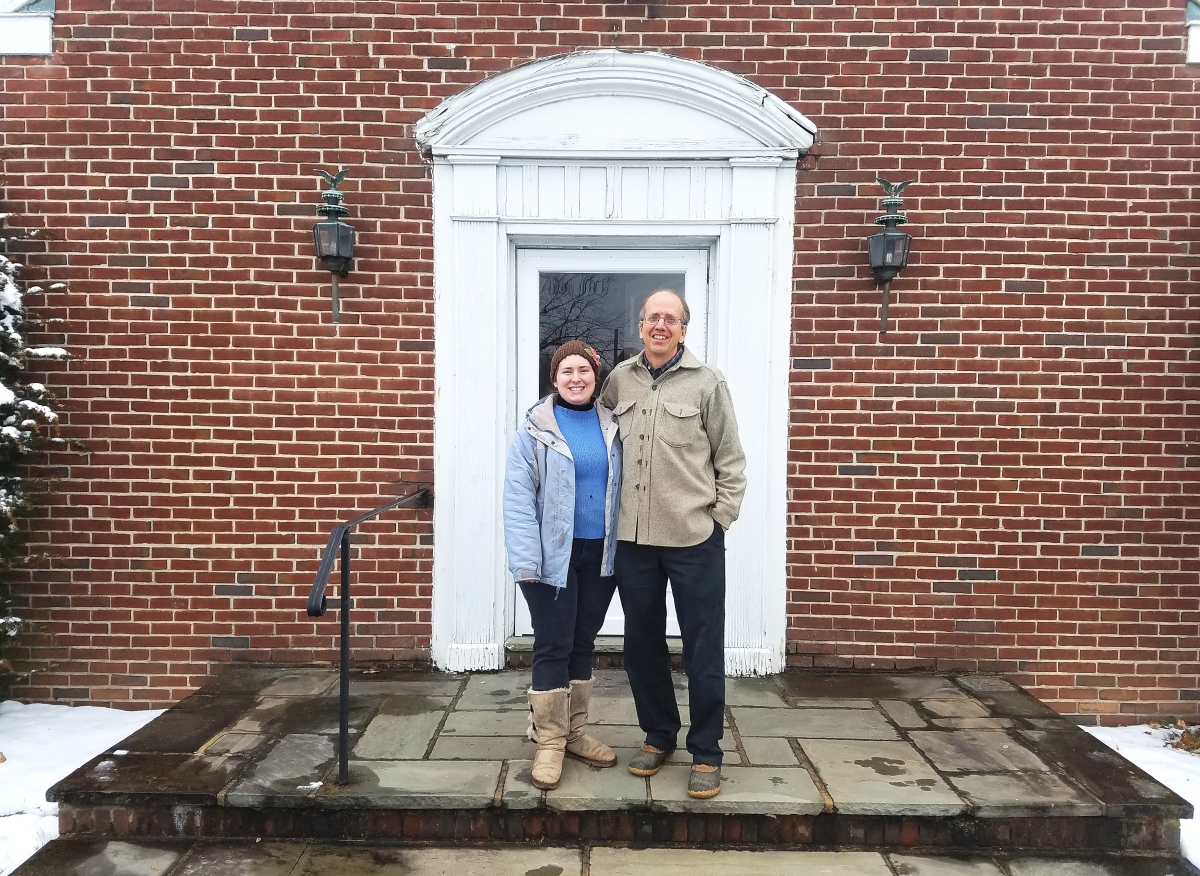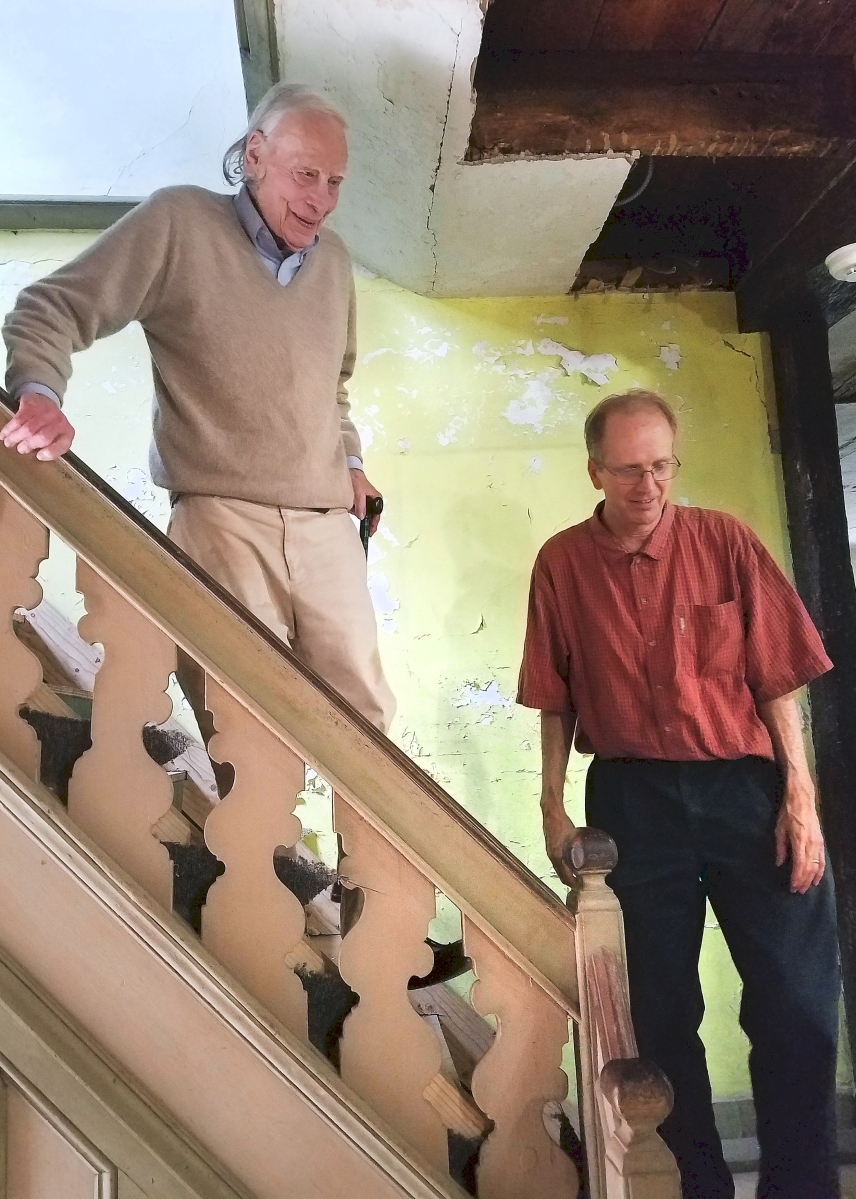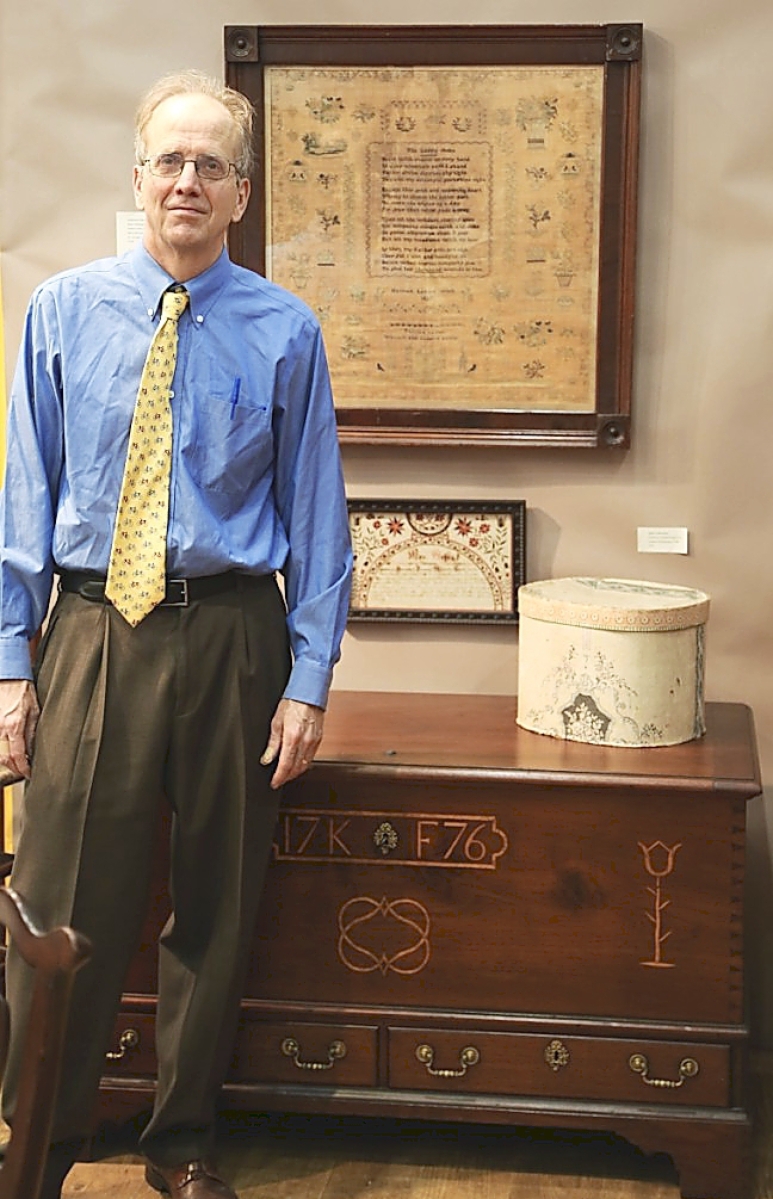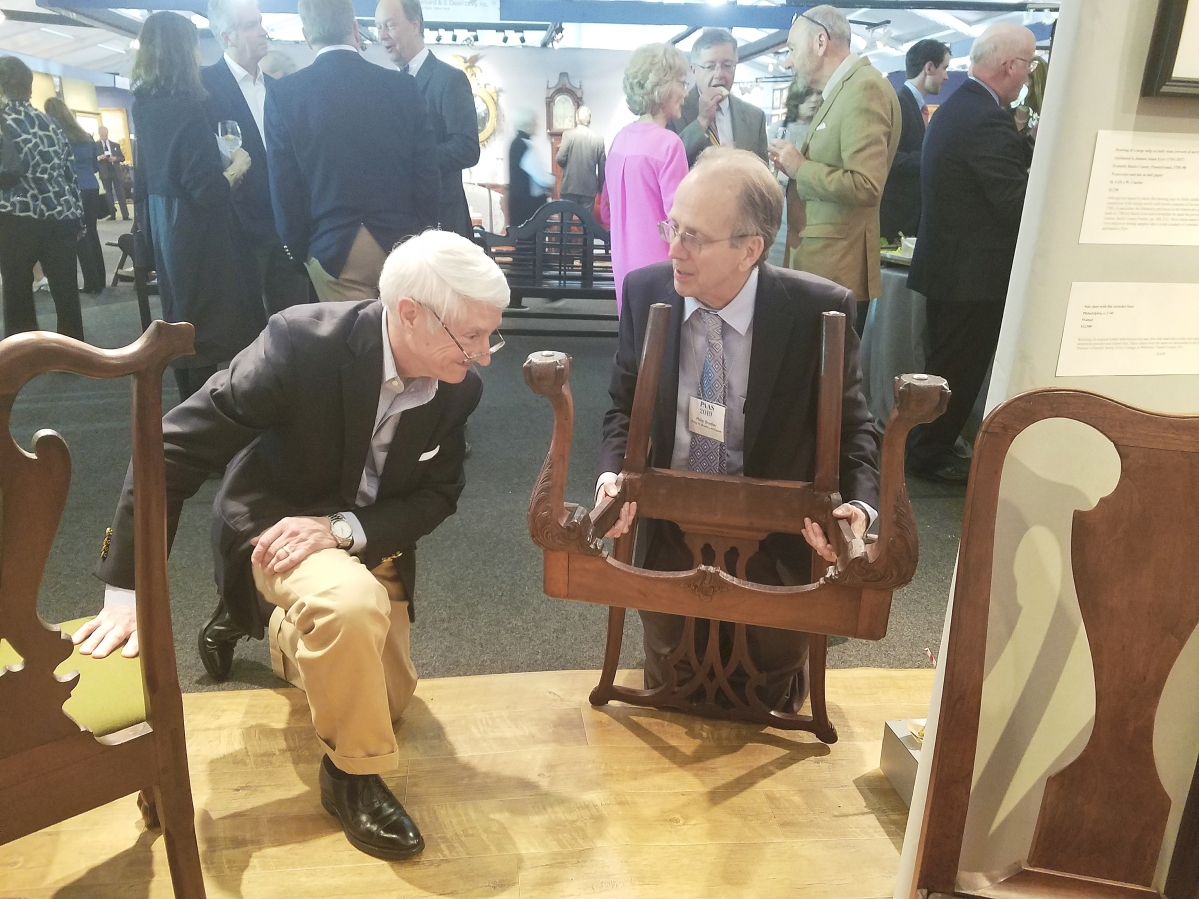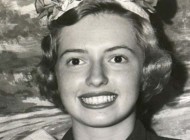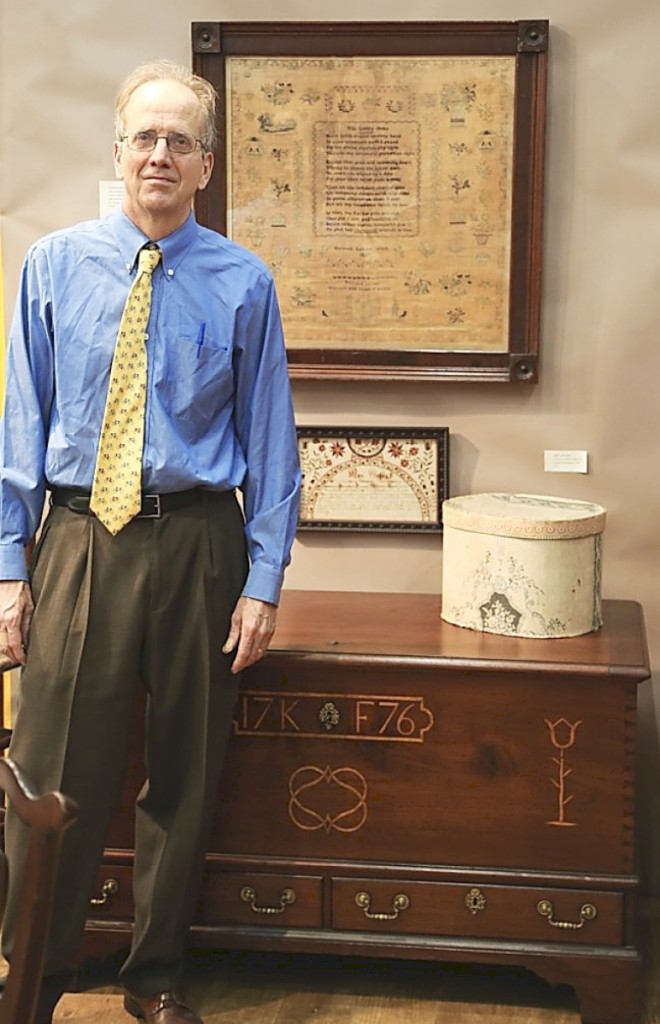
Philip Bradley stands before a 1776 Chester County chest-over-drawers in walnut with mixed-wood inlay. The large 1827 needlework at the top came in its original mahogany frame and was worked by Hannah Levis (1810-1836). Antiques and The Arts Weekly photo.
By Madelia Hickman Ring
Philip Wells Bradley, late of Downingtown, Penn., passed away at the age of 65 on October 3, at the historic house near Sumneytown, Penn., that he restored and shared with his beloved wife Lisa Minardi, who survives him. The cause of death was cancer.
Born in West Chester, Penn., on March 30, 1956, he was one of three children of the late antiques dealer, Philip H. and Frances (Galt) Bradley. Philip attended the Haverford School (’74) and Rhode Island School of Design (’78), where he pursued an interest in making and designing furniture and ceramics.
Philip was a life-long member of Downingtown Friends Meeting. He loved music, contra dancing, bicycling, cross-country skiing and rowing. He worked with – and eventually succeeded – his father in the family antiques business, Philip H. Bradley Co., in Downingtown. He specialized in fine Americana, especially Pennsylvania furniture and clocks, eventually broadening his interests to include Minardi’s passion: Pennsylvania German fraktur.
Philip was deeply loved by all who knew him as a kind, caring, gentle and honest man.
He met Minardi when she was working on the Winterthur book (and corresponding exhibition of the same name), Paint, Pattern, and People: Furniture of Southeastern Pennsylvania 1725-1850; they married on September 15, 2012.
“We met in 2008 or 2009 when I was working on Paint, Pattern and People. I was checking out his booth and quickly realized he was far more knowledgeable than I was, particularly on clocks. At the time, I was going through a divorce, and he helped me move my books, which I think was a bit of a shock because he had not realized how many I had.
“The key part to our relationship was in February 2010, when the deadline for the book manuscript was approaching. I was living near Winterthur, and we had an enormous snowstorm. I was so focused on finishing the manuscript that I was completely oblivious. He called to make sure I was OK, and I was starting to panic because I had no power and no food, worried I wouldn’t finish the manuscript. He was living in Downingtown and he and a friend, who had a four-wheel drive vehicle, came down and they evacuated me to his house, which I’d never been to because we’d always met at my house to work on the manuscript. I moved in for the weekend and he cooked while I worked. I never really left.
“Philip was one of the nicest people I ever met. I would really like to emphasize how much he supported me in all of my endeavors – attending lectures and traveling to Germany with me, going back to grad school for my PhD., helping provide objects to furnish the Henry Muhlenberg House, to install the galleries of our new Center for Pennsylvania German Studies, etc. And in buying our historic house, the Daniel Hiester House near Sumneytown in Montgomery County, Penn., and working on its restoration over the past four years. We enjoyed collecting objects for furnishing the house and making floor plans of where everything would go, which we started to implement recently as the major restoration begins to conclude.”
When asked how Philip would have liked to be remembered, Minardi said “He was such a humble person – he would not have viewed it that way,” but noted that he had sold antiques to major institutions all over the country, including Chipstone, the Metropolitan Museum, Winterthur, MESDA, Philadelphia Museum of Art, Colonial Williamsburg, Chester County Historical Society and many others.
Minardi plans to continue the business, though she was not yet sure how that would happen.
Ron Pook, founder of Pook & Pook, Inc., had been Bradley’s neighbor on Downingtown’s East Lancaster Avenue for about 50 years; it was a proximity that was not accidental.
“Philip’s dad was one of the most reputable antique dealers in the country. I thought ‘I’ll rent a place next door and make a million!’ With a lot of antiques, sometimes the provenance isn’t so good but if it had a Bradley provenance, it was golden.
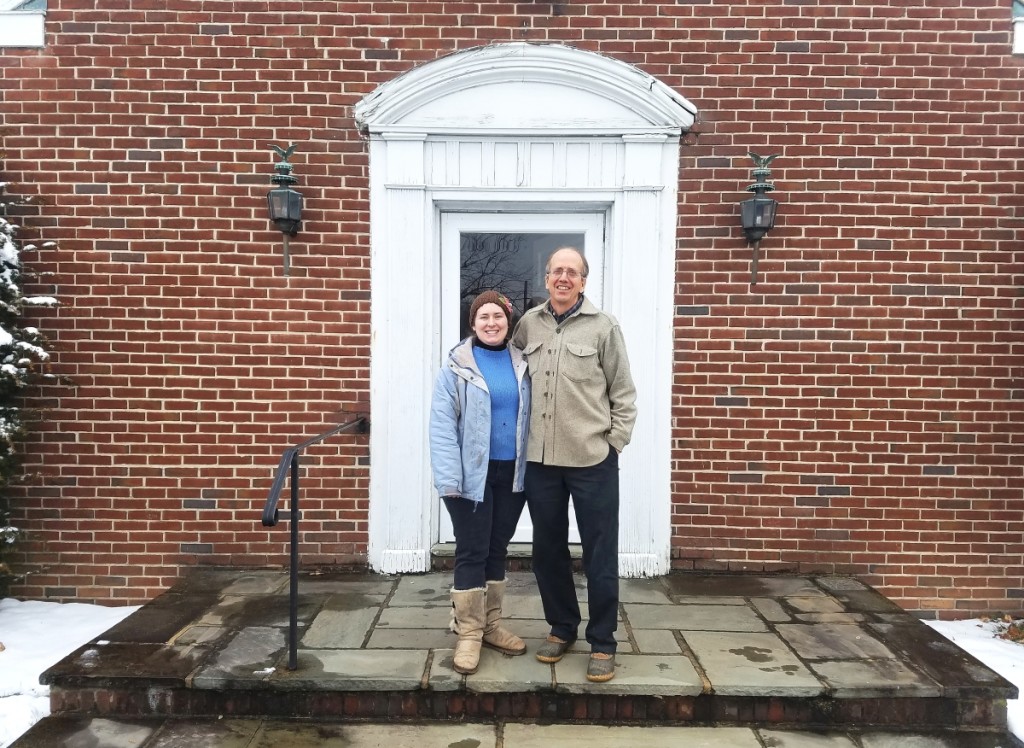
Lisa and Philip in front of the old shop in Downingtown, totally exhausted after having spent the past week in final push to clean out the building prior to its sale on March 1, 2018. His father built the shop in 1956. Courtesy Lisa Minardi.
“Philip’s dad was a dealer’s dealer – he loved buying and selling and would buy across the board; Philip was more selective, and it elevated their business. Philip was more of a scholar than a dealer. He was a wonderful, soft spoken, kind man but he was the worst salesman because he was more interested in the piece than selling it. He had the knowledge to tell you what was right and wrong – that was really wonderful. I’ll miss him for his intensity and objectivity. He was so lucky to have such a wonderful, devoted wife in Lisa.”
“He was a lifelong bachelor; his interests in the American Decorative Arts were so consuming that it was wonderful that he met Lisa, who shared many of those interests with him,” said American decorative arts historian, Jay Robert Stiefel. He remembered Bradley’s shop was where Winterthur used to hold classes. “Phil had a range of the same form at different price points so you could instantly compare and train your eye. That was very useful.” Stiefel had fond memories of acquiring “The Juggler’s Chest” from the Bradleys in 1989. The walnut miniature chest inlaid with equestrian performances started him on a 25-year quest to find chests by the same maker, a topic he ultimately wrote an article about.
“I’ll miss him for a lot of reasons,” fellow dealer, Kelly Kinzle said. “He had so many different interests and layers. You didn’t often see it – he was all business 99 percent of the time, but Lisa brought him out of his shell and brought out the best of him.”
John Nye worked with the Bradleys in the early 90s, alongside recently deceased dealer Chris Rebollo.
“Philip was kind and had a gentle soul. He loved family, friends, history, music, dancing and flying under the radar. Over the years he handled some great objects for a stable of well-heeled collectors out of the shop in Downingtown. His disheveled appearance disarmed the competition, not just at country auctions but at the grand exhibitions hosted by the legacy houses in New York. Philip had a keen eye, abundant knowledge, and strong desire to figure out exactly what may have happened to a piece of furniture, which meant that as five o’clock approached, the galleries were closing and his shopping list was not yet exhausted, I would allow him to stay late and then to spend the night. I can still hear Philip, legs crossed at the kitchen table, enthused about Kathy’s impromptu vegetarian dinner, solving the world’s problems in his characteristically cracking voice. Outside of work, we went to concerts, retrofitted a cap for my truck in sub-zero temperatures, built a miniature blanket chest for an anniversary present and generally enjoyed each other’s company. When the time came, I was sorry to leave the familial setting for the Big City, but what I learned at Philip Bradley Antiques catapulted me into my career. I will miss Philip. May he will now find the Holy Grail of Pennsylvania furniture.”
“I had the opportunity to work with Philip from 1997 to 2008,” John Renshaw said, recalling a memory he and Philip shared from 2006. “A porter at the New York Folk Art Show, who was moving a rare paint-decorated chest into our booth, asked Philip how much it was worth. Philip started his usual slow detailed explanation to the man about the chest. Five minutes, ten minutes, 20 minutes until finally he emerged out of his dream-like tutorial to someone unlikely to purchase an antique. That porter shook Phillip’s hand thanking him multiple times for explaining the chest and its value. On his way out of the booth he stopped, looked back at Philip and said, ‘you know if I had that kind of money, I’d buy me a new car.’ Philip loved it and lept into the air clicking his heels like Mr Bojangles.
“The show took place February 11-12, 2006, during a blizzard that blanketed the city with over 27 inches of snow. Philip and I spent the day manning the booth and tending to a few customers who dared to venture out during the blizzard. Our hotel was two blocks away so off we trudged through 16 inches of wet snow wearing dress shoes. Back at the hotel I settled in for the evening only to be awoken by Philip knocking on my door. He proceeded to convince me that we had to take advantage of a once-in-a-lifetime opportunity to experience a paralyzed New York City in blizzard conditions. Around 10 pm, we went down past Central Park in our soggy dress shoes. The snow was coming down at about 2 inches an hour, keeping all motorized vehicles sidelined for the night. By around 11, we managed to make it to the amazing Times Square all lit up in neon. Suddenly I noticed Philip was down on his back doing snow angels in the middle of Times Square. Later he told me that doing those snow angels made the whole New York show experience special. Looking back at that night, Philip taught me that happiness is all around us, we just have to learn to embrace the little things in life like doing snow angels. Philip was true to himself and always considered the feelings of others.”
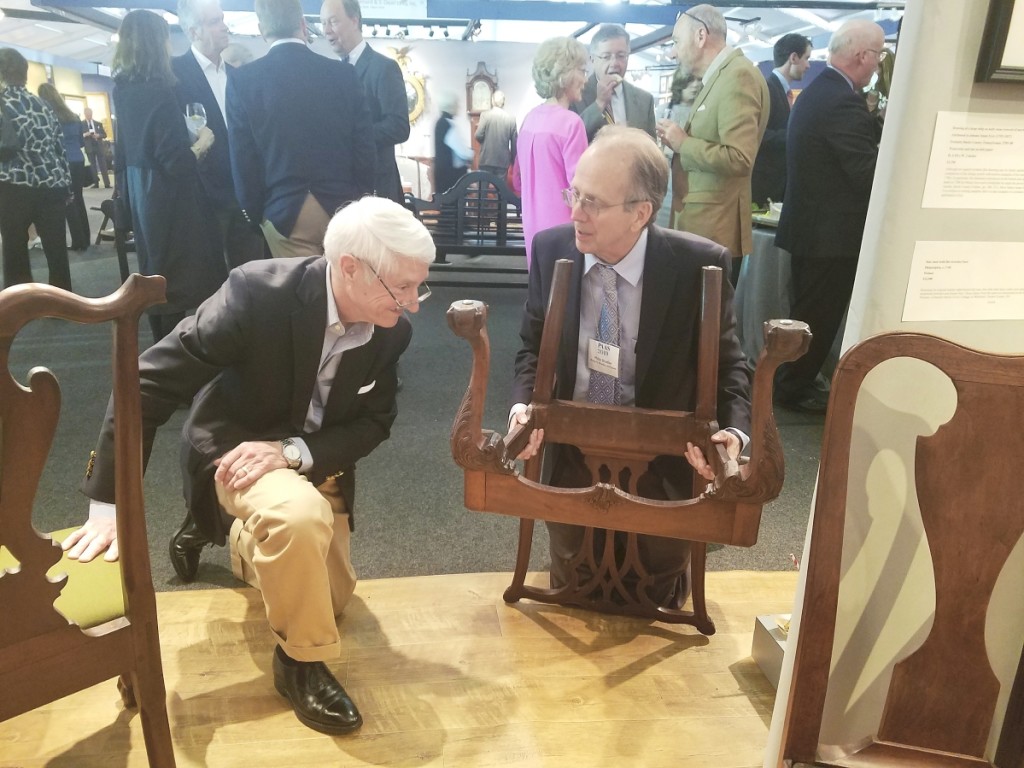
Philip showing a Philadelphia Chippendale chair to a customer at the 2019 Philadelphia Antiques Show. Courtesy Lisa Minardi
Clockmaker and restorer David Lindow was preparing to give a lecture on a Rittenhouse clock he restored for Bradley when he heard the news that Bradley had passed; he told Antiques & The Arts Weekly he would dedicate the lecture to him.
“My heart broke when I heard about Philip. He was so much more than a customer. He was a gentleman amongst gentlemen, to be sure. When I got the news on Sunday it seemed so appropriate that I was just finishing up a David Rittenhouse restoration that I’d had to work straight through the night to finish. It was so appropriate because for so many years, the days leading up to major shows so often were sleepless finishing up some of the best clocks I ever worked on for him. It would be days before a show, and he’d spring something on me. I never said no, and we never missed one for a show.
“In a real sense, he made my restoration career. We were introduced by Alan Miller, and Philip gave me a few jobs to test me out. I was 28 years old with a lot of confidence in my skills and training but way out of my league in the antiques world that was to become my home. I was young and brash and full of life but not all that experienced and definitely intimidated by the high-profile antiques world. Philip gave me the chance to get that experience and treated me with respect from day one. I came to sympathetic restoration naturally, but Philip pushed me to my limits – and beyond. He recognized my talent and trusted my instincts while guiding me in getting the results that he wanted. I’d been trained very well, but almost no one would support the kind of work financially that I aspired to do. Philip saw it for what it was and pushed me for more. He pushed and pushed and pushed and cajoled me into saving original parts when it was, quite frankly, not very rational. We did it though, and he taught me things I couldn’t have learned from anyone else. We sort of taught each other what was possible. He made me better, and in a real sense he made my career.
“I’ll miss that happy dance he did when it all came together just right. I remember two days before one of the big Philly shows I delivered a clock with a brass dial. I typically read what he wanted well, and that was hard; but this time I could tell he just didn’t like it. After some conversation, we came up with a plan. I’d worked through the previous night to get the clock down to him, but he wasn’t happy. Not that he’d say that exactly, but he didn’t hide his feelings on such things well. Becky was with me. She drove home, I slept in the back of the van, and when I got home, I went back to work and went through the night again. The happy dance ensued. It was worth it. That dance was the best. That’s when you knew you nailed it; and his tastes were impeccable. I can truly say that I am as good as I am at restoration largely because of Philip. The ceiling would have been so much lower without him.
“None of this can really say who he was to me though either. He was so much more. In a world of scalawags, he stood out as absolutely honest, true. He was true to the core in every way. I worked for very, very few dealers; but I’d go to the wall for him. He was such a beautiful person; and my life is so much better for having known him. I am now in my 50s and passing on the knowledge of what I learned. When I had a serious student, I’d take them to see his shop, meet him and show the student his clocks; and it would always leave a lasting impression. I’ll miss those experiences, but I’ll miss his personality a whole lot more.”
“The Bradleys were very forthcoming with their knowledge. Always very honest and open and willing to share knowledge,” said fellow American furniture dealer, H.L. “Skip” Chalfant. “I’ve known young Philip Bradley since he was 13 years old and his goal in life then was to polish an andiron as well as I could. He was very enthusiastic and eager to learn even at that age. As he grew older, he was the kindest human being I know. I once saw him pick up a big black bug and carry it outside to release it. That was indicative of Philip Bradley’s nature. He was always very generous with his knowledge and fierce competitor at auctions. The Bradleys are responsible for inspiring me to be the antique dealer I am today.
“I can’t think of anything bad to say about him. The only thing people didn’t like was when he showed up at auction because he was a tough competitor. There are too many occasions when he outbid me!”
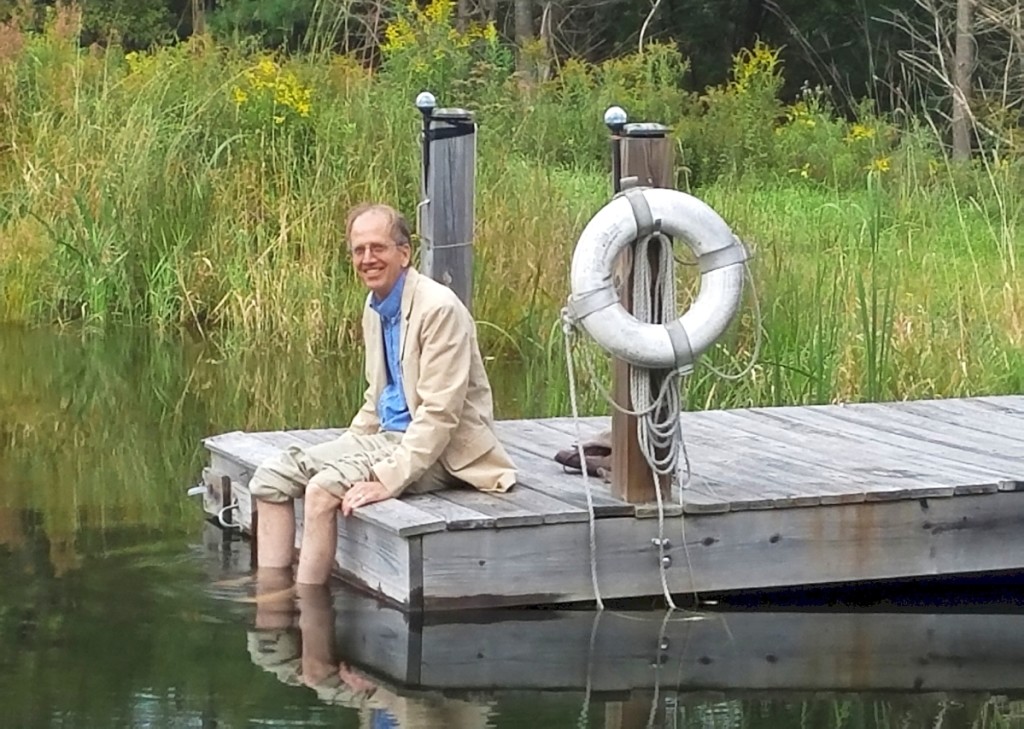
Philip sitting on the couple’s friend Ed Dixon’s dock at a lake in northern Pennsylvania. To Lisa, this photo captures Philip’s love of the water and his joyful spontaneity. Courtesy Lisa Minardi.
Alan Miller recalled the time he and Philip were on the same flight to Milwaukee to attend Dudley Godfrey’s funeral. The airport in Milwaukee was closed because of bad weather and the flight was diverted to Fargo, N.D., where they stayed the night. The next day, they returned to Philadelphia, never making it to Milwaukee. “Philip was completely unperturbed,” Miller remembered. “He just looked at things as optimistically as possible under the circumstances. The most vivid thing about him to me was what a good person he was. His example helped, and still helps me, to aspire to be a good person – a better person.”
H. Richard Dietrich III of the Dietrich American Foundation shared that the foundation had acquired from Philip and Lisa a vorschrift (writing sample) signed by Martin Gottschall, brother and son of Samuel Gottschall and Jacob Gottschall, who were also fraktur artists. The vorschrift was historically important because it provided researchers with a much-needed “Rosetta stone” to distinguish between the work of the three men, who rarely signed their work.
“It was not a big sale but one we were thrilled to have. Philip has been someone I’ve always had deep regard for. I typically saw him at shows in Wilmington or Philadelphia, where I’d seek him out. He was so giving of his time, talking about the pieces he had but not in a pushy way. He was a consummate gentleman, so scholarly, so quiet but always made his presence known. My father also had a real regard for both Philip and his father.”
Philip is survived by a brother Mark H. Bradley, husband of Anne (Gilles) Bradley, of Devon, Penn.; a sister Virginia G. Bradley, wife of Bruce S. Fitch, of Frisco, Colo; nieces and nephews Alexander B. Fitch, Rachel V. Fitch, Christy Anne Bradley, Luke A. Bradley and Matthew H. Bradley; in-laws Kate and Silvio Minardi; several cousins, and many close friends.
A public gathering to celebrate Philip’s life will be held at 2 pm on Saturday, October 23, at St John’s Lutheran Church, 3104 Main Street, Green Lane, Penn. The service will be followed by a reception at the Bradley-Minardi residence. Shuttle service from St John’s will be provided. Please RSVP to bradleyantiques@gmail.com.
Those wishing to make a donation in Philip’s memory can donate to Historic Trappe (www.historictrappe.org) or the Downingtown Friends Meeting (www.downingtownfriendsmeeting.org).

